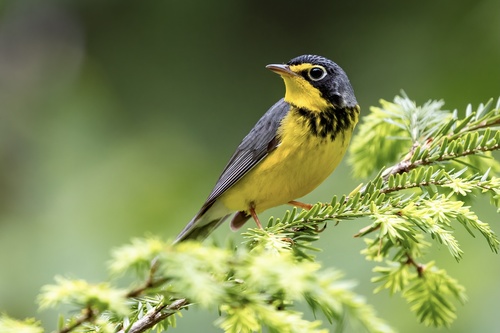
Canada Warbler
The Canada Warbler (*Cardellina canadensis*) is a small, vibrant songbird known for its striking plumage and energetic behavior. It plays a vital role in controlling insect populations within its forested habitats. This species is a long-distance migrant, breeding in the boreal forests of North America and wintering in the montane forests of northern South America. It holds no particular cultural significance other than being a welcome sight for birdwatchers and a symbol of healthy, intact forests.
12-15 cm
Length
17-22 cm
Wingspan
Least Concern
Conservation Status
Distribution
Breeds across Canada from eastern British Columbia to Nova Scotia, and south into the northeastern United States. Winters primarily in northern South America, including Colombia, Ecuador, Peru, and Venezuela. Migrates through Central America and the Caribbean.
Lifespan
Typically 3-5 years in the wild, but can live up to 7 years.
Canada Warbler's Habitat
Habitat Types
Mature deciduous and mixed forests, Riparian woodlands, Shrubby thickets, Bogs and swamps with dense undergrowth
Climate Zones
Temperate, Boreal, Tropical (during wintering)
Adaptations
Prefers areas with a dense understory, allowing it to forage and nest close to the ground, protected from predators. Its agility allows it to navigate complex vegetation.
Variations
No recognized subspecies.
Appearance
Breeding Plumage
Males in breeding plumage have bright yellow underparts, a bluish-gray back, and a distinctive black 'necklace' across the chest. Females are similar but duller, with a less distinct necklace. Non-breeding plumage is slightly duller overall.
Seasonal Feather Changes
Slight dulling of colors after breeding season.
Sex Based Plumage Differences
Males are more brightly colored and have a more prominent black necklace than females.
Notable Features
Bold white eye-ring, Black 'necklace' (more prominent in males), Yellow underparts, Bluish-gray upperparts
Diet and Feeding
Primary Foods
Insects, Spiders, Caterpillars, Beetles, Flies
Foraging Behavior
Actively gleans insects from leaves and branches in the understory and lower canopy. Often forages by hovering and picking insects from foliage, or by making short sallies to catch flying insects.
Specializations
Its small size and agility allow it to access insects in dense vegetation that larger birds cannot reach.
Seasonal Diet Variations
Diet primarily consists of insects throughout the year. May occasionally eat small berries during migration or on wintering grounds when insects are scarce.
Behavior
Social Structure
Generally solitary or in pairs during the breeding season. May form small flocks during migration and on wintering grounds.
Communication
A distinctive, high-pitched 'chip' call., A complex, variable song, often described as 'chip-che-wee-o-wit'.
Migration
A long-distance migrant, traveling thousands of kilometers between breeding and wintering grounds. Migrates at night.
Territorial or Group Behaviors
Males are territorial during the breeding season, defending their nesting area from other males. On wintering grounds, they may defend feeding territories.
Conservation
Threats
Habitat loss and degradation (both on breeding and wintering grounds), Collisions with buildings and other structures during migration, Pesticide use (reducing insect prey), Climate change (potential shifts in habitat suitability)
Protection Programs
Habitat conservation initiatives in breeding and wintering areas, Efforts to reduce bird collisions (e.g., bird-friendly building design)
Local National Laws
Protected under the Migratory Bird Treaty Act in the United States and Canada.
Population Trend
Decreasing
Population Estimates
Estimated global population of 5.5 million individuals (Partners in Flight).
Interesting Facts
They are one of the latest warblers to arrive on their breeding grounds in spring.
This may be related to their preference for mature forests with a well-developed understory, which leaf out later in the season.
The 'necklace' of black streaks on the male's chest is unique to this species among North American warblers.
This makes it relatively easy to identify, even for novice birdwatchers.
They often nest on or near the ground, making them vulnerable to predators.
This nesting behavior necessitates a dense understory for concealment and protection.
Canada Warbler populations have declined significantly in recent decades.
This is likely due to a combination of factors, including habitat loss and climate change.
Faqs about Canada Warbler
Where is the best place to see a Canada Warbler?
Look for them in mature deciduous or mixed forests with a dense understory during the breeding season (May-July). Check eBird for recent sightings in your area.
What does the Canada Warbler's song sound like?
It's a complex, variable song, often described as 'chip-che-wee-o-wit'. You can listen to recordings online at websites like All About Birds or the Macaulay Library.
Are Canada Warblers endangered?
While not currently listed as endangered, their populations are declining. They are listed as 'Least Concern' by the IUCN, but are considered a species of conservation concern in many areas.
What can I do to help Canada Warblers?
Support habitat conservation efforts, reduce pesticide use, and make your windows bird-friendly to prevent collisions. You can also participate in citizen science projects like eBird to help track their populations.
Copyright @ Nature Style Limited. All Rights Reserved.
 English
English